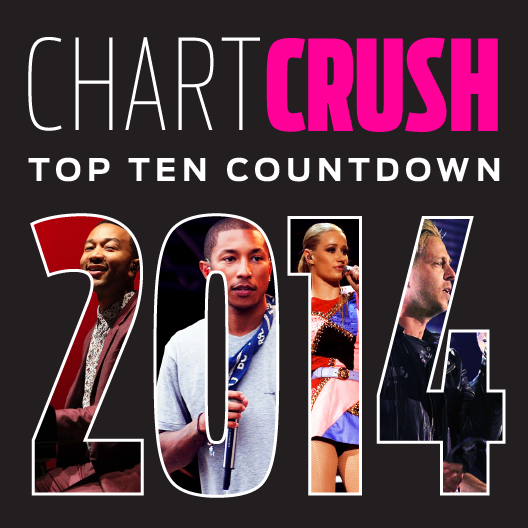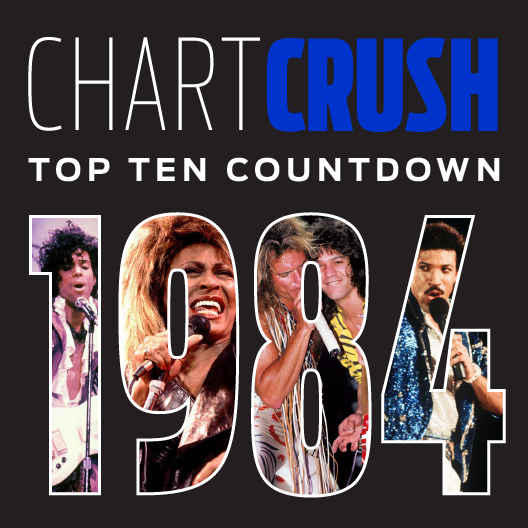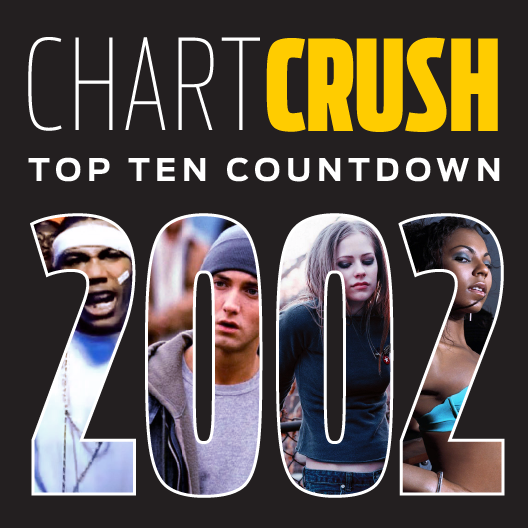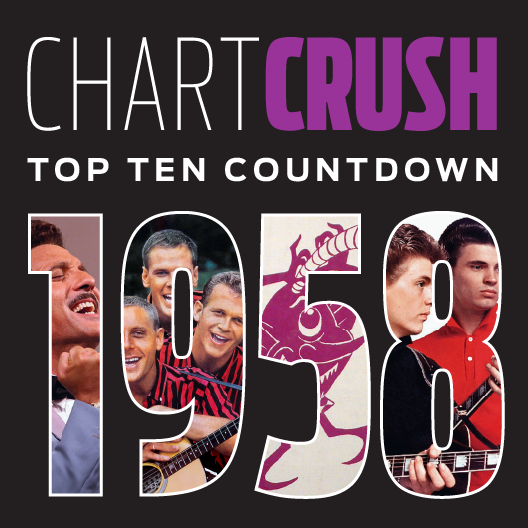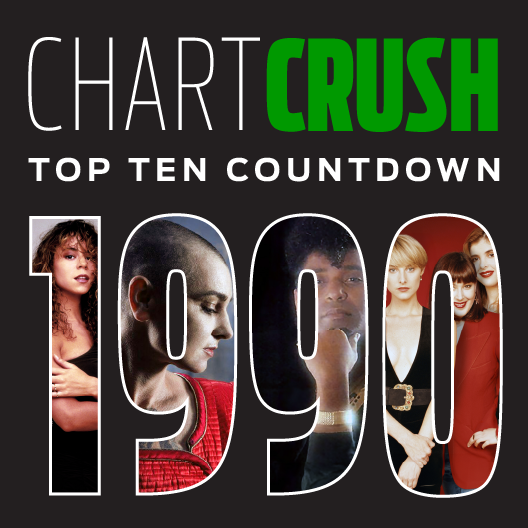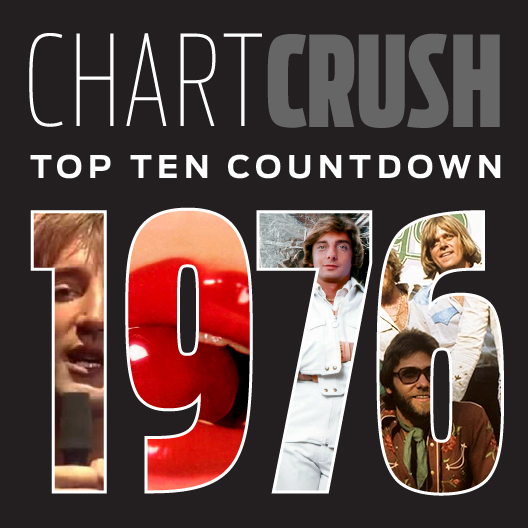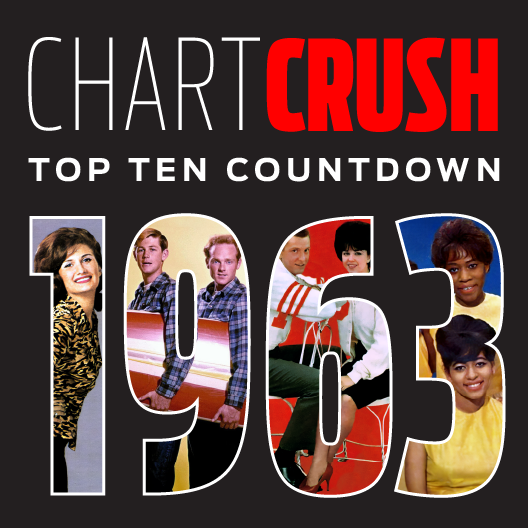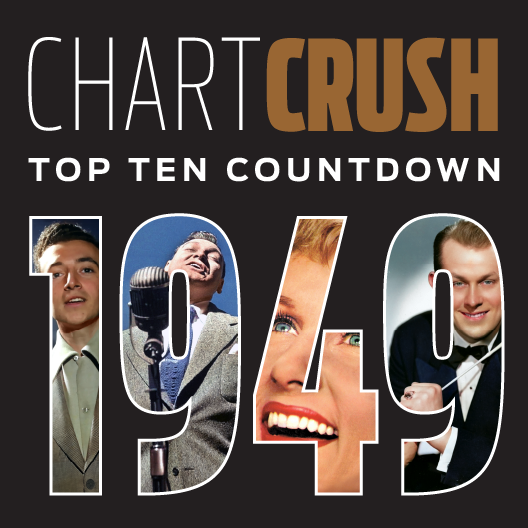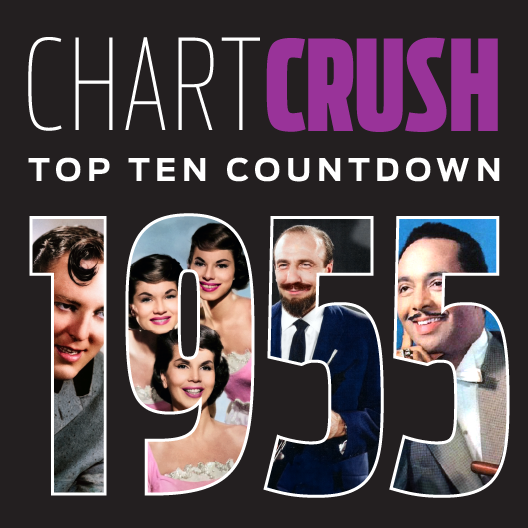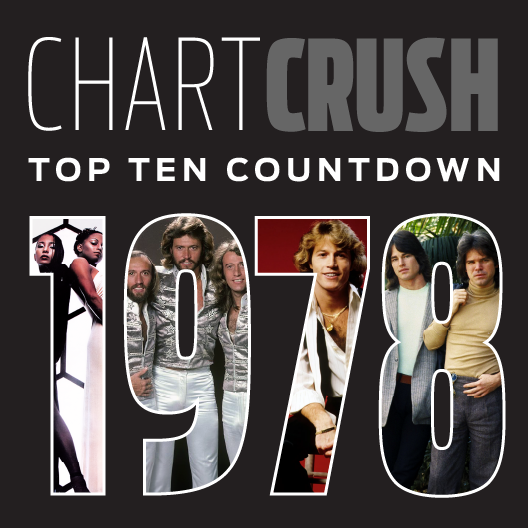
1978 Top Ten Pop Countdown Podcast
Peak Disco with The Bee Gees and Andy Gibb dominating, two blockbuster movie soundtracks, Lionel Richie’s first massive Pop-Soul-AC crossover and Yacht Rock!
::start transcript::
Welcome to the Chartcrush Top Ten Countdown Show, I’m your host, Christopher Verdesi. Every week on Chartcrush, we dive deep into a year in pop music and count down the top ten songs according to our exclusive recap of the weekly pop charts published at the time in the music industry’s top trade publication and chart authority, Billboard magazine. This week on Chartcrush, we’re turning the clock back to 1978. Peak Disco! In the movies, on TV, in the fashion magazines, in advertising, and on the Pop charts: everywhere! Even food! An article in Smithsonian in 2011 detailed how a woman made her husband’s birthday dinner using recipes published in the year he was born: 1978. The title of the article? “Tastes like Disco.”
After ramping up for three years, by ’78, every city had a thriving Disco scene with multiple clubs: first time since the early ’40s that dancing was a full-blown industry in America. Discos were even out in the middle of nowhere. They sprung up almost overnight, just as described in Wild Cherry’s big hit “Play That Funky Music:” an autobiographical song about a Rock band in, of all places, Appalachia that suddenly finds itself with nowhere to play because all the clubs that used to hire them for gigs have switched to Disco. That was in ’76. After Saturday Night Fever hit the big screen at the end of ’77, starring John Travolta as a working-class, Disco-obsessed, huckapoo-shirt wearing Italian-American in Brooklyn, New York, the Disco craze was in full bloom.
Hundreds of radio stations switched to a Disco format in ’78. One in New York flipped from playing Adult Contemporary in July to become “WKTU Disco 92,” and by December its audience had increased eight-fold and it was the #1 station in the city, even beating out longtime top 40 leader WABC.
And of course, people switched to Disco! Anyone who lived through the late ’70s knew someone, at school, in their family, or just out and about, who suddenly showed up one day with the clothes and the hair. Clothing stores and hair salons of course switched to Disco too, and the overnight personal makeovers they wrought were impossible to miss because the glamor, sophistication, glitter and glitz of Disco was the polar opposite of the whole grungy jeans and flannel pot-smoking rural Hippie thing that had hung around since the ’60s.
Even Rock got a facelift. Van Halen debuted in ’78: out of the Hollywood Glam Rock scene, mentored by KISS’s Gene Simmons: a whole new, flashy, swaggering, blow-dried and decked-out look and matching sound that helped set the template for Rock in the ’80s. Nothing Disco about Van Halen’s music, of course, but for lots of oldskool Rock heroes it wasn’t just a new, flashier, cleaned-up look. The Rolling Stones, Rod Stewart, Alice Cooper, Chicago, Jefferson Starship and even The Grateful Dead on “Shakedown Street…” all those and many more incorporated Disco grooves into their music in the late ’70s. And the drip-drip-drip of those encroachments as Disco peaked musically and culturally brewed a backlash, which boiled over in ’79: Disco Demolition Night in Chicago. That’s a story for another episode.
But it wasn’t just Rock. Funk and R&B, of course, were the wellsprings of Disco, but glossier, smoother Disco upstarts crowded out several acts who were thriving on the Pop and R&B charts pre-Disco: James Brown, Gladys Knight & The Pips, Kool & The Gang, Pointer Sisters, Moments, Whispers–even Motown superstars like Diana Ross and former Temptation Eddie Kendricks. Some of those surged back with massive Post-Disco hits in the ’80s, but others failed to adapt.
#10 Commodores – Three Times a Lady
Now Disco wasn’t the only way a Soul/R&B/Funk act could adapt to changing sounds and fashions. With the leading edge of the Baby Boom generation now in or approaching their thirties, the Adult Contemporary radio format was modernizing. In ’79, Billboard finally got around to re-naming its “Easy Listening” chart to “Adult Contemporary,” reflecting the format’s long drawn-out shift away from the Traditional Pop and Orchestral acts that’d dominated in the ’60s toward Singer-Songwriters and Soft Rock in the ’70s. And in ’78, our song at #10 as we kick off our Countdown, proved that ballads rooted in R&B could cross over and get massive airplay on AC radio right alongside the latest hits by Barry Manilow, Barbra Streisand and Roberta Flack. It was #1 on the Easy Listening chart for three weeks, all while topping the Soul/R&B chart and the Hot100 late in the Summer of ’78: Lionel Richie’s biggest hit while he was still in his group The Commodores: “Three Times a Lady.”
On the strength of his massive ballad hits with The Commodores, Lionel Richie became one of the most in-demand songwriters in the biz, not only writing but producing Kenny Rogers’ biggest hit, “Lady” in 1980 and soon after launching his solo career: one of the most successful of the ’80s. For their part, The Commodores followed up their massive 1977 R&B/Pop/Dance hit “Brick House” with “Too Hot ta Trot.” That topped the Soul/R&B chart, but couldn’t crack the top 20 on the Hot100 as Disco continued edging out the group’s preferred hard Funk sound.
#9 Paul Davis – I Go Crazy
We’re counting down the top hits of 1978 here on this week’s Chartcrush Top Ten Countdown Show, and up next at #9 is another ballad, this one a Soft Rock song about realizing that you’re not over your ex. It only got to #7, but it was on the Hot100 for 40 weeks, August ’77 to May of ’78. That’s the longest chart run of any 1978 song by a mile, and it set a new record for chart longevity that stood for nearly five years. It’s Singer-Songwriter Paul Davis, his first top ten hit after cranking out albums and singles for nearly ten years: “I Go Crazy.”
Paul Davis’s “I Go Crazy,” #9 as we count down the top ten hits of 1978 here on the Chartcrush Top Ten Countdown Show. Davis had another good year in 1982 with a pair of top 20 hits, “Cool Night” and “’65 Love Affair:” both of those staples of latter-day so-called “Yacht Rock” playlists of Soft Rock hits from the late ’70s and ’80s. Interestingly, “I Go Crazy” was not an Easy Listening/Adult Contemporary hit, despite Davis being in the top ten on that chart for six weeks in late ’74 into ’75 with his story song, “Ride ‘Em Cowboy.”
#8 Player – Baby Come Back
And speaking of Yacht Rock, our #8 song will also ring a bell for fans of the genre: a genre, by the way, that wasn’t defined as such until the mid-’00s, when the mockumentary Yacht Rock debuted in an online amateur film festival, parodying the stories of late ’70s and ’80s Soft Rock acts, and went viral. The group is from Yacht Rock’s epicenter, Los Angeles, California, and on the strength of their three top 40 hits in the year, they were Billboard’s top New Singles Artist of 1978. It’s Player: “Baby Come Back.”
Player. “Baby Come Back,” #8, often mistaken for Daryl Hall & John Oates, the Philadelphia Soft Rock Blue-Eyed Soul duo who are specifically mocked in the aforementioned Yacht Rock mockumentary. Player broke up after a falling out between the founding members later in ’78, but Hall & Oates did successfully transition into the ’80s New Wave era and beyond. John Oates has credited the Yacht Rock series with rekindling interest in Hall & Oates in the ’00s, especially among Millennials. Player’s other top ten hit from 1978, “This Time I’m in It for Love,” often mistaken for another big late ’70s Yacht Rock act, Steely Dan.
#7 A Taste of Honey – Boogie Oogie Oogie
Well if you’ve been patiently waiting to hear some Disco here on our Chartcrush Top Ten Countdown for 1978, your wait is over. And it’s a good segue from the softer sounds we kicked off with at numbers 10 through 8, because while it’s definitely Disco, it’s also got a bit of that laid-back ’70s Soft Rock chill too. They were a hit right out of the gate: first album, first single (which is our #7 song)—and one of a handful of acts throughout chart history who named themselves after song titles, in this case a song from a 1960 Broadway show that was covered by everyone from The Beatles to Barbara Streisand, before Herb Alpert took it into the top ten in 1965, “A Taste of Honey.” At #7, “Boogie Oogie Oogie.”
A Taste of Honey, “Boogie Oogie Oogie” at #7. Acts named after songs: “Boyz II Men” was a song by New Edition before it became the name of the Philly R&B vocal group that ruled the charts in the ’90s. “Radio Head” was a Talking Heads song. “Deep Purple,” a #1 hit by Nino Tempo & April Stevens in 1963. “Death Cab for Cutie,” a song by the ’60s British avant garde outfit The Bonzo Dog Doo-Dah Band. Just a few of the song-title named acts through the years besides “A Taste of Honey,” again, named after the Herb Alpert hit.
They followed up “Boogie Oogie Oogie” with more Disco, but things changed fast in ’79 with the “Disco Sucks” backlash, and they would almost certainly have been a one-hit wonder if they hadn’t bucked their label and producers and kept their cover of Kyu Sakamoto’s 1963 hit “Sukiyaki” a ballad. The song had been a favorite of singer Janice-Marie Johnson as a kid—and with the new English lyrics she wrote, they took it into the top five in 1981.
#6 Andy Gibb – (Love Is) Thicker than Water
OK, we’re down to #6, and I’ve gotta throw this out there: from here on in our Chartcrush Top Ten Countdown for 1978, five of the songs (that’s five of the top six songs of the year) are by four brothers. I don’t mean slang “brotha’s.” No! Literally four brothers, in the same family, with the same parents! Well that’s unique in chart history! The oldest three, Barry and fraternal twins Maurice and Robin, had been the nucleus of their group The Bee Gees since the mid-’60s. But in ’77, here came the youngest, as a solo act. But really in name only; all his stuff came out of the same hit making factory (songwriting, production and everything in between) as The Bee Gees. Our #6 song was peaking on the charts on his 20th birthday in March: his second #1 after 1977’s “I Just Want to Be Your Everything,” it’s Andy Gibb “(Love Is) Thicker Than Water.”
“(Love Is) Thicker Than Water,” the first of two Andy Gibb songs in our Chartcrush Top Ten Countdown of the biggest hits of 1978, and the first of five by the Gibb brothers collectively: solo act Andy Gibb and his older brothers’ group The Bee Gees. By the way, their sister, Lesley, the oldest of the lot: never involved in her brothers’ musical ventures except for a brief spell in 1969 when she replaced Robin onstage after he temporarily quit to pursue a solo career.
#5 Exile – Kiss You All Over
Now our song at #5 is the #1 song of 1978 (as long as you don’t count the Gibb brothers)! It’s the first hit by a regional Kentucky bar band who’d been at it since the early ’60s. And it ranks #10 on a special Billboard list of the “Sexiest Songs of All-Time” published in 2022. Its over-the-top steaminess, not lost on New York’s biggest top 40 station at the time, WABC, who refused to put it on the air until it hit #1 nationally at the end of September and they couldn’t not play it, for a run of four weeks on top. It’s Exile’s “Kiss You All Over.”
Exile “Kiss You All Over:” #5 on our Chartcrush Top Ten Countdown for 1978. Now viewers staying up late for The Midnight Special in 1978… that was the show after Johnny Carson on Friday nights in the ’70s and one of the few places you could see music on TV pre-MTV… well, those folks got to see Exile front man Jimmy Stokley delivering those deep, Barry White-inspired vocals at the beginning of “Kiss You All Over” looking like a glammed-up version of Pink Floyd’s Roger Waters in a one-piece body suit. Which explains why Glam Rock producer Mike Chapman took such an interest in them, and eventually gave them his song “Kiss You All Over.”
Chapman and songwriting partner Nikki Chinn had already launched Glam Rock act The Sweet out of L.A. (their top tens “Little Willy” and “Ballroom Blitz”), and Nick Gilder’s New Wavey “Hot Child in the City,” which replaced “Kiss You All Over” at #1. Next up for Chapman in ’79 was Blondie’s Parallel Lines album, which included their breakout hits “Heart of Glass” and “One Way or Another.” And then The Knack’s debut including “My Sharona.” Quite a roll for Mike Chapman!
On the Pop charts, Exile was a one-hit wonder, but after flashy front man Jimmy Stokely quit in 1980, they retooled and scored ten #1’s on the Country charts in the ’80s. In 1997, Dance Pop trio No Mercy (most famous for their top ten hit “Where Do You Go?”) did a flamenco-y House version of “Kiss You All Over” and scored a #1 hit on the Dance chart.
#4 Bee Gees – Stayin’ Alive
Well we’re down to the small numbers in our countdown, and for 1978, that can mean only one thing: Bee Gees! At #4, here’s “Stayin’ Alive!”
The song that came to epitomize not just The Bee Gees, but really the whole Disco craze, “Stayin’ Alive,” from the year’s #1 album, the double-LP soundtrack to the movie Saturday Night Fever and 1978’s #4 song according to Billboard, as well as our Chartcrush Top Ten Countdown Show ranking. In the movie it’s in the opening credits scene:John Travolta as Tony Manero walking down the sidewalk in his neighborhood in Brooklyn all decked out in his dancing clothes even in the middle of the day, eating two stacked slices of pizza and carrying a can of paint back to his family’s hardware store, checking out the clothes and boogie shoes in the store windows while “Stayin’ Alive” plays in sync with his footsteps.
Saturday Night Fever catapulted not just Disco music, but the Disco scene to the pinnacle of Pop culture, one of just a handful of zeitgeists throughout history that galvanized America so completely that it’s hard to even think of the year without a half a dozen sights and sounds flooding your mind: John Travolta in his white three-piece polyester suit and The Bee Gees (the tallest, Barry, in the middle), shiny, gold-satin varsity-style jackets unbuttoned to show off their prodigious chest hair. Your mileage may vary with the specific sights and sounds, but you get the point.
#3 Bee Gees – How Deep Is Your Love
The Saturday Night Fever soundtrack yielded three #1 hits for The Bee Gees, but “Stayin’ Alive” wasn’t the first. The first was our next song at #3, and it entered the Hot100 a full three months before the movie even hit theaters. It’s the ballad, “How Deep Is Your Love.”
Bee Gees, “How Deep Is Your Love,” #3 as we count down the top ten hits of 1978 here on the Chartcrush Top Ten Countdown Show. In 2001, Barry Gibb said that was his favorite Bee Gees song: a big deal because there have been so many Bee Gees songs. Hundreds!
The Bee Gees didn’t just materialize in the Disco era; they’d scored their first hits, a string of them, in ’67 and ‘8. At the end of the ’60s though, like a lot of groups, they got caught between Pop and the more serious Progressive and Blues-oriented Album Rock that was being championed by Hippie media outlets like Rolling Stone—unable to plant their flag in either camp. After a brief slump and breakup they got their Beatlesesque “Lonely Days” and the dreamy ballad “How Can You Mend a Broken Heart” into the top five in ’70 and ’71, but slumped again—until Soul/R&B producer Arif Mardin came into their lives a few later. “Jive Talkin'” was a #1 hit in ’75, and the album it was on, Main Course, featured the first appearance on a record of what became Barry Gibb’s trademark: his falsetto!
#2 Andy Gibb – Shadow Dancing
Well we’re going to continue with our mini Brothers Gibb marathon, also known as the top four songs of 1978, at #2 with Andy Gibb’s biggest hit of the year. We heard “(Love Is) Thicker Than Water” back at #6. Andy got a songwriting assist from brother Barry on that one, but all three Bee Gees contributed on this one. And it shows! Almost indistinguishable from any of The Bee Gees hits from Saturday Night Fever. And why wouldn’t it be with the same songwriters and producers: The Bee Gees’ in-house production team of Barry Gibb, Albhy Galuten and Karl Richardson: Gibb-Galuten-Richardson. At #2, it’s Andy Gibb, “Shadow Dancing.”
With “Shadow Dancing,” Andy Gibb became the first solo act in chart history to score #1’s with his first three singles. It was #1 for seven weeks: 1978’s big Summer hit, after all three of the Bee Gees’ hits from Saturday Night Fever had finished their chart runs in the first half of the year. Same songwriters, same producers, even the same label as The Bee Gees and the Saturday Night Fever soundtrack album: RSO Records for “Robert Stigwood Organization,” with its red cow logo inspired by a Japanese legend. Besides the Bee Gees and Andy Gibb, our #8 song, Player’s “Baby Come Back,” was also on RSO, for a total of six out of the ten top records of 1978.
Music and showbiz entrepreneur Stigwood had been The Bee Gees’ manager all the way back to their first charting singles in 1967, and it was his idea to turn a Tom Wolfe-style essay in New York magazine into Saturday Night Fever, which he produced, and cast John Travolta, whom he’d just signed to a three picture contract, to play the lead.
Fun fact: the author of the essay Stigwood bought the movie rights to, a Brit named Nik Cohn, admitted in the ’90s that he’d made it all up; his actual experiences attempting to research New York’s working-class outer borough Disco scene had mostly consisted of arriving at the 2001 Odyssey club in Brooklyn’s Bay Ridge neighborhood while a drunken brawl was in progress outside, and being thrown up on before he was even out of his taxicab.
#1 Bee Gees – Night Fever
And we’re down to #1 on our Chartcrush Top Ten Countdown for 1978. It’s Saturday Night Fever’s title track. Well, sort of. When the song was written, the working title for the movie was simply “Night Fever.” Ultimately, that was rejected for being too vague. Could be a zombie flick, or a disaster movie about a mysterious disease, right? So they went with Saturday Night Fever. But the song was already done. Again, The Bee Gees, the biggest of their three hits—all from Saturday Night Fever—among 1978’s top records, “Night Fever.”
For two weeks end of February into March, all three of the Bee Gees’ hits from Saturday Night Fever were in the top ten, “How Deep Is Your Love,” “Stayin’ Alive” and the #1 song of 1978 according to our Chartcrush Top Ten Countdown Show ranking, the song we just heard, “Night Fever.” And Andy Gibb’s “(Love Is) Thicker than Water” (our #6 song) was #2 both of those weeks. It doesn’t get much bigger than that on the charts, and the Brothers Gibb rode the wave with three more #1s late ’78 into ’79, “Too Much Heaven,” “Tragedy” and “Love You Inside and Out” from their follow-up album Spirits Having Flown.
But then the bottom dropped out of the Disco craze, and the early ’80s were tough times for Disco icons. Barry Gibb and The Bee Gees biggest successes post ’79 came writing and producing other artists. Barry teamed up with Barbra Streisand, writing, producing and singing backup on her 1980 smash “A Woman in Love,” our #8 song of 1980. By then, Andy Gibb was already deep in the throes of his addiction to cocaine and alcohol, and his erratic behavior got him fired from his roles in Broadway plays and hosting the TV show Solid Gold, cost him his relationship with actress Victoria Principal, and was the cause of his tragic death from heart failure in 1988, just days after he turned 30.
Billboard ranked Andy’s “Shadow Dancing” as the #1 song of 1978. Well, it was on the chart five weeks longer, but “Night Fever’s” eight weeks at #1 (up against “Shadow Dancing’s” seven), plus its additional week in the top ten gives it the edge in our Chartcrush ranking algorithm.
Bonus
Now, usually in our bonus segment of Chartcrush, after we finish the countdown, we look at the differences between our top ten and the top ten on Billboard‘s published year-end Hot100 chart. Some years there are lots of differences. But for ’78: only Paul Davis’s “I Go Crazy” (our #9 song) isn’t in Billboard‘s top ten. They had it at #12. And the only song from Billboard‘s top ten not in ours is their #3 song, which was Debby Boone’s “You Light Up My Life,” which winds up our #1 song of 1977 counting it’s full chart run, including its amazing ten straight weeks at #1 just before Saturday Night Fever hit theaters at the end of ’77.
So in the time we have left, we’re gonna do something a little different. We’re gonna put the exclamation point on the The Bee Gees and RSO Records’ dominance in 1978 by looking at five more hits on RSO that in addition to the six we heard in our countdown, were all in the top 20 on the year.
#17 Samantha Sang – Emotion
And three of those, written and produced by The Bee Gees, starting with our #17 song that most people in ’78 thought was a Bee Gees song. And except for the minor detail of the Lead Singer whose name is on the record, it really was a Bee Gees record! Co-written by Barry and Robin Gibb and produced by Gibb, Galuten & Richardson, but sung by an Australian Singer who’d first worked with the Bee Gees in the U.K. in 1969, it’s Samantha Sang’s “Emotion.”
Something I didn’t mention when we heard the Bee Gees’ two biggest hits of ’78: on March 18 when “Night Fever” hit #1 and “Stayin’ Alive” moved up to #2, The Bee Gees became the first act since The Beatles in 1964 to lock down the top two spots on the Hot100 the same week. Samantha Sang’s “Emotion” was #3 that week.
#19 Yvonne Elliman – If I Can’t Have You
At #19 was the lone #1 hit from Saturday Night Fever not performed by the Bee Gees on the soundtrack album, but the song was written by, yep, Barry, Robin and Maurice Gibb, and their version was the B-side of the “Stayin’ Alive” single. The final #1 from Saturday Night Fever, Yvonne Elliman’s “If I Can’t Have You.”
It was Bee Gees Manager, RSO Records founder and Saturday Night Fever mastermind Robert Stigwood who decided to use Yvonne Elliman’s version of “If I Can’t Have You” in the movie, and have The Bee Gees record the song she was originally slated to do, “How Deep Is Your Love.”
#20 Frankie Valli – Grease
Now Stigwood had another big culture-shaking movie later in ’78, and its soundtrack was another #1 double album on RSO. Our #20 song of 1978 was the title song that Barry Gibb wrote for the project, performed by Four Season Frankie Valli, “Grease.”
Elvis Presley died in August of ’77 and ’50s nostalgia sitcoms Happy Days and Laverne & Shirley were the top two shows on TV, both on the ABC network. Grease couldn’t miss.
#15 Olivia Newton-John and John Travolta – You’re the One That I Want
It was the second movie in actor John Travolta’s three-picture deal with Stigwood’s RSO Films, co-starring Olivia Newton-John, whose singing career had slumped when Disco hit. But her radical image makeover from sweet ’70s Country-Pop cupcake to ’80s “Physical” sexpot Diva happens right there onscreen as her and Travolta sing the movie’s other #1 hit, not a Gibb song, but on the RSO label: “You’re the One That I Want.”
Saturday Night Fever might’ve beat Grease on the Hot100 and album charts, but not at the box office. Grease was 1978’s top grossing movie, by a lot.
#13 Eric Clapton – Lay Down Sally
And finally, our #13 song, nothing to do with The Bee Gees, Grease or Saturday Night Fever, but on Robert Stigwood’s RSO label, for a grand total of 11 of the top 20 hits of 1978, all on RSO. It grabbed the #3 spot behind “Night Fever” and “Stayin’ Alive” from Samantha Sang’s “Emotion” at the beginning of April, and those remained the top three songs, in that order, for the next three weeks. It’s Eric Clapton’s “Lay Down Sally.”
Eric Clapton went even further back with Robert Stigwood than The Bee Gees, all the way to the start of his ’60s supergroup Cream, with Ginger Baker and Jack Bruce. The RSO label’s first U.S. release was by Clapton’s early ’70s band Derek & The Dominoes.
Well that’s all we have for you in our 1978 edition of The Chartcrush Top Ten Countdown Show. I’ve been your host, Christopher Verdesi. Thanks for listening! On our website, chartcrush.com, you can find a written transcript and a link to stream this and other Chartcrush countdown shows on Spotify, plus chart run line graphs and other jivin’ extras. Every week, we count down a different year from the beginning of the charts in the ’40s all the way up to the present, so tune again, same station, same time, for another edition of Chartcrush.
::end transcript::

